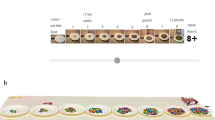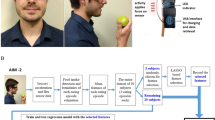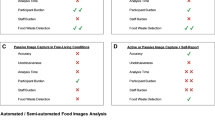Abstract
Objective:
In diet surveys, quantitative underestimation of food consumption may be due to intentional misreporting or false portion-size reporting. Perception of food photographs used as aids for assessing the actual amounts may have an effect. This study was carried out to assess the validity of food photographs.
Design:
A real-time test protocol where 52 presented food servings were compared against photographed portions with similar food items.
Subjects:
Volunteers from the Rehabilitation Company Petrea (in Turku) were recruited, 161 adults participated, and for 146 subjects, complete data were collected.
Methods:
The proportions of correct estimations and reporting errors, in weights and percentages, are presented by gender and food group. Food descriptors, portion-size options and subject characteristics were studied as potential determinants of accuracy in portion-size estimation.
Results:
The total proportion of exactly correct estimations was 51% in men and 49% in women. The overall reporting error was −10 g in men and +1 g in women for the 52 food servings. Underreporting was typical for bread, spread and cold cuts and dishes in both genders. Over-reporting was typical for cereals in both genders and for snacks, vegetables and fruit in women. The estimation error was associated with the portion-size options but not associated with the energy density of food items, education or body mass index.
Conclusions:
Food portions in photographs seem to be a useful aid for the quantification of most food items. However, validation studies are needed to test the applicability of photographs for estimating current portions and for searching better tools in dietary surveys.
This is a preview of subscription content, access via your institution
Access options
Subscribe to this journal
Receive 12 print issues and online access
$259.00 per year
only $21.58 per issue
Buy this article
- Purchase on Springer Link
- Instant access to full article PDF
Prices may be subject to local taxes which are calculated during checkout



Similar content being viewed by others
References
Anttolainen M, Javanainen J, Kaartinen P, Lahti-Koski M, Lauronen J, Männistö S et al. (1998). The 1997 dietary survey of Finnish adults. Publications of the National Public Health Institute B8/1998.
Ayala G (2006). An experimental evaluation of a group- versus computer-based intervention to improve food portion size estimation skills. Health Edu Res 21, 133–145.
Chambers E, Godwin S, Vecchio F (2000). Cognitive strategies for reporting portion sizes using dietary recall procedures. J Am Diet Assoc 100, 891–897.
Frobisher C, Maxwell S (2003). The estimation of food portion sizes: a comparison between using descriptions of portion sizes and a photographic food atlas by children and adults. J Hum Nutr and Diet 16, 181–188.
Geier A, Rozin P, Doros G (2006). Unit bias. A new heuristic that helps explain the effect of portion size on food intake. Psychol Sci 17, 521–525.
Haapa E, Toponen T, Pietinen P, Räsänen L (1985). Picture booklet of food portions (Annoskuvakirja). National Public Health Institute: Helsinki.
Hernández T, Wilder L, Kuehn D, Rubitzky K, Moser-Veillon P, Godwin S et al. (2006). Portion size estimation and expectation of accuracy. J Food Comp and Anal 19 (Suppl), S14–S21.
Hirvonen T, Männistö S, Roos E, Pietinen P (1997). Increasing prevalence of underreporting does not necessarily distort dietary surveys. Eur J Clin Nutr 51, 297–301.
Karvetti R-L, Knuts L-R (1985). Validity of the 24-hour dietary recall. J Am Diet Assoc 85, 1437–1442.
Krebs-Smith S, Graubard B, Kahle L, Subar A, Cleveland L, Ballard-Barbash R (2000). Low energy reporters vs others: a comparison of reported food intakes. Eur J Clin Nutr 54, 281–287.
KTL, National Public Health Institute (2005). The Finnish food composition database Fineli®, version 5.http://www.fineli.fi.
Lara J, Scott A, Lean M (2004). Intentional mis-reporting of food consumption and its relationship with body mass index and psychological scores in women. J Hum Nutr Diet 17, 209–218.
Lucas F, Niravong M, Villeminot S, Kaaks R, Clavel-Chapelon F (1995). Estimation of food portions size using photographs: validity, strengths, weaknesses and recommendations. J Hum Nutr Diet 8, 65–74.
Matthiessen J, Fagt S, Biltoft-Jensen A, Beck A, Ovesen L (2003). Size makes a difference. Public Health Nutr 6, 65–72.
Männistö S, Ovaskainen M-L, Valsta L (2003). The national FINDIET 2002 study. Publications of the National Public Health Institute B3 (in Finnish, with English tables, figures and summaries).http://www.ktl.fi/julkaisut/julkaisusarja_b/2003b3..
Nelson M, Haraldsdottir J (1998). Food photographs: practical guidelines I. Design and analysis of studies to validate portion size estimates. Public Health Nutr 1, 219–230.
Nielsen S, Popkin B (2003). Patterns and trends in food portion sizes, 1977–1998. J Am Med Assoc 289, 450–453.
Noethling U, Hoffmann K, Bergmann M, Boeing H (2003). Portion size adds limited information on variance in food intake of participants in the EPIC-Potsdam study. J Nutr 133, 510–515.
Pekkarinen M (1970). Methodology in the collection of food consumption data. World Rev Nutr Diet 12, 145–171.
Pietinen P, Hartman A, Haapa E, Räsänen L, Haapakoski J, Palmgren J et al. (1988). Reproducibility and validity of dietary assessment instruments. I. A self-administered food use questionnaire with a portion size picture booklet. Am J Epidemiol 128, 655–666.
Slimani N, Deharveng G, Charrondière R, van Kappel A, Ocké M, Welch A et al. (1999). Structure of the standardized computerized 24-h diet recall interview used as reference method in the 22 centers participating in the EPIC project. Comp Meth Prog Biomed 58, 251–266.
Smith A (1991). Cognitive processes in long-term dietary recall. National Center for Health Statistics, Vital and Health Statistics Series 6, 1–34.
Statistics Finland (2006). Time use survey of families. www.stat.fi loaded 3.7.2006.
Turconi G, Guarcello M, Berzolari FG, Carolei A, Bazzano R, Roggi C (2005). An evaluation of a color food photography atlas as a tool for quantifying food portion size in epidemiological dietary survey. Eur J Clin Nutr 59, 923–931.
Vartiainen E, Laatikainen T, Tapanainen H, Salomaa V, Jousilahti P, Sundvall J et al. (2003). Changes in cardiovascular risk factors in the National FINRISK Study between 1982 and 2002 (in Finnish: Suomalaisten sydän- ja verisuonitautien riskitekijät FINRISKI-tutkimuksessa 1982–2002). Suomen Lääkärilehti 58, 4099–4106.
Acknowledgements
The study was funded by budgetary money from KTL and the premises for the implementation of the study were provided by Rehabilitation Company Petrea.
Author information
Authors and Affiliations
Corresponding author
Additional information
Contributors: All authors read and approved the manuscript. M-LH contributed to analysis of data; JL contributed to study design and collection of data; SM contributed to study design and in writing the article; M-LO contributed to study design, analysis of data and in writing the article; MP contributed to study design, collection of data and in writing the article; OPP contributed to collection of data and in writing the article; HR contributed to study design and in writing the article; HS contributed to analysis of data and in writing the article.
Supplementary Information accompanies the paper on European Journal of Clinical Nutrition website (http://www.nature.com/ejcn)
Supplementary information
Rights and permissions
About this article
Cite this article
Ovaskainen, ML., Paturi, M., Reinivuo, H. et al. Accuracy in the estimation of food servings against the portions in food photographs. Eur J Clin Nutr 62, 674–681 (2008). https://doi.org/10.1038/sj.ejcn.1602758
Received:
Revised:
Accepted:
Published:
Issue Date:
DOI: https://doi.org/10.1038/sj.ejcn.1602758
Keywords
This article is cited by
-
Development and validation of an online tool to assess perceived portion size norms of discretionary foods
European Journal of Clinical Nutrition (2023)
-
An evaluation of a virtual atlas of portion sizes (VAPS) mobile augmented reality for portion size estimation
Virtual Reality (2021)
-
Validation of a self-administered web-based 24-hour dietary recall among pregnant women
BMC Pregnancy and Childbirth (2018)
-
Using digital photography in a clinical setting: a valid, accurate, and applicable method to assess food intake
European Journal of Clinical Nutrition (2018)
-
The international food unit: a new measurement aid that can improve portion size estimation
International Journal of Behavioral Nutrition and Physical Activity (2017)



